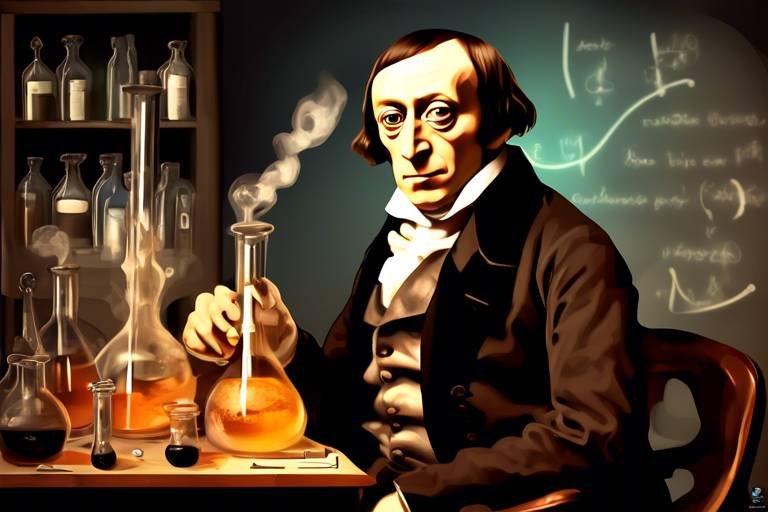The Life of Gregor Mendel and His Genetic Discoveries
Gregor Mendel, often hailed as the father of genetics, embarked on a remarkable journey that would forever change our understanding of heredity. Born on July 20, 1822, in a small village in what is now the Czech Republic, Mendel was a curious child with a profound fascination for nature. From a young age, he exhibited a keen interest in the world around him, which eventually led him to study philosophy and natural sciences at the University of Vienna. It was here that he laid the intellectual groundwork for his future groundbreaking research.
Mendel's life was not just about academic pursuits; it was also shaped by his spiritual journey. After completing his studies, he joined the Augustinian monastery in Brünn (now Brno), where he found a nurturing environment that provided him with the resources necessary for scientific exploration. The monastery's garden became his laboratory, and it was here that he conducted his famous experiments on plant hybridization. His work would later establish the foundational principles of inheritance, which are still relevant in modern genetics.
What makes Mendel's story particularly fascinating is how he chose to work with pea plants. This decision was strategic; pea plants have distinct traits that are easily observable, such as flower color and seed shape. By meticulously documenting the outcomes of his experiments, Mendel was able to uncover the principles of dominance, segregation, and independent assortment. His findings were revolutionary, yet they remained largely unrecognized during his lifetime, highlighting the often-unappreciated nature of groundbreaking scientific work.
In summary, Gregor Mendel's life and discoveries serve as a testament to the power of curiosity and perseverance. His innovative approach to studying heredity not only laid the groundwork for modern genetics but also inspired future generations of scientists. Mendel's legacy continues to influence research in genetics and biology, making him a pivotal figure in the history of science.
- What is Mendel known for? Mendel is primarily known for his foundational work in genetics, particularly his laws of inheritance based on experiments with pea plants.
- When were Mendel's findings recognized? Mendel's work was published in 1866 but was largely ignored until its rediscovery in the early 20th century.
- Why did Mendel use pea plants for his experiments? Pea plants were chosen because they have easily observable traits and can be cross-pollinated, making it easier to study inheritance patterns.
- What are the key principles established by Mendel? The key principles include the Law of Segregation and the Law of Independent Assortment, which describe how traits are inherited from one generation to the next.

Early Life and Education
Gregor Mendel was born on July 20, 1822, in a small village called Heinzendorf, located in what is now the Czech Republic. From an early age, he exhibited a profound curiosity about the world around him. Growing up in a farming family, he spent countless hours observing the plants and animals that surrounded him. This connection to nature ignited a passion for science that would shape his future. Can you imagine a young boy, captivated by the simple beauty of a garden, unknowingly laying the groundwork for one of the most significant scientific breakthroughs in history?
Mendel's formal education began at a local school, where he excelled in his studies. His talent for mathematics and natural sciences became apparent, prompting him to pursue further education. In 1843, he entered the Augustinian monastery in Brünn (now Brno), where he took the name Gregor. This decision was pivotal, as the monastery provided him with both a supportive environment and access to resources that would facilitate his scientific inquiries.
During his time in the monastery, Mendel studied philosophy and natural sciences at the University of Vienna. His education was comprehensive, encompassing a wide range of subjects, including physics, mathematics, and botany. These disciplines equipped him with the analytical skills necessary for his future experiments. It was here that Mendel began to realize the potential of blending his love for nature with scientific inquiry.
While at the university, Mendel was particularly influenced by the works of renowned scientists such as Charles Darwin and Jean-Baptiste Lamarck. Their ideas about evolution and heredity inspired him to explore the mechanisms behind the traits passed from one generation to the next. He often pondered questions like: "How do traits appear in offspring?" and "What determines the characteristics of living organisms?" These inquiries would later drive him to conduct his groundbreaking experiments with pea plants.
In the quiet solitude of the monastery, Mendel found the perfect backdrop for his research. Armed with knowledge and a fervent desire to uncover the secrets of heredity, he began to experiment with plant hybridization. His early life experiences and education had prepared him for this moment, setting the stage for a series of experiments that would change the understanding of genetics forever.

Monastery Life and Research
Gregor Mendel's journey into the world of genetics truly took flight during his time in the Augustinian monastery in Brünn, now known as Brno, in the Czech Republic. This serene environment, steeped in tradition and discipline, provided the perfect backdrop for Mendel's scientific explorations. Imagine a place where the hustle and bustle of the outside world fades away, leaving only the whisper of nature and the rustle of leaves—this was Mendel's laboratory, a sanctuary where he could immerse himself in his passion for science.
Within the monastery walls, Mendel had access to a wealth of resources that were crucial for his research. The monks were encouraged to pursue intellectual endeavors, and Mendel seized this opportunity. He was able to cultivate a deep understanding of natural sciences, which included botany, physics, and mathematics. This interdisciplinary approach was vital; it wasn't just about studying plants but understanding the underlying principles that governed their growth and reproduction.
During his time there, Mendel conducted numerous experiments, but it was his work with pea plants that would ultimately change the course of genetics. He meticulously selected pea plants for their distinct traits—such as flower color, seed shape, and pod color—allowing him to observe and document patterns of inheritance. The monastery's garden became his experimental playground, where he could cross-pollinate plants and track the results over generations. This hands-on approach was revolutionary, as it laid the groundwork for what would later be known as the laws of inheritance.
One of the most fascinating aspects of Mendel's research was his methodical record-keeping. He created detailed tables to organize his findings, which helped him identify trends and draw conclusions. Here’s a simplified example of how he might have tracked his data:
| Trait | Parental Generation (P) | First Generation (F1) | Second Generation (F2) |
|---|---|---|---|
| Flower Color | Purple | Purple | 3 Purple : 1 White |
| Seed Shape | Round | Round | 3 Round : 1 Wrinkled |
Through these experiments, Mendel was able to uncover fundamental genetic principles, including the concepts of dominance and segregation. His work was not just about plants; it was a profound exploration of life itself. The monastery life, with its blend of spiritual reflection and scientific inquiry, allowed Mendel to think deeply about the nature of inheritance and the mechanisms that govern it.
However, despite the significance of his findings, Mendel's work was largely overlooked during his lifetime. The scientific community was not yet ready to embrace the revolutionary ideas he presented. Yet, the seeds of his discoveries were sown, waiting for the right moment to germinate in the minds of future scientists.
In summary, Mendel's time in the monastery was not just a phase of his life; it was a critical period where he transformed from a curious monk into the father of genetics. The environment provided him with the solitude and resources necessary to delve into the mysteries of heredity, ultimately leading to discoveries that would shape the future of biology.
- What inspired Mendel to study genetics? Mendel's fascination with nature and his background in natural sciences motivated him to explore the principles of heredity.
- Why did Mendel choose pea plants for his experiments? Pea plants had distinct traits that were easy to observe, making them ideal for studying patterns of inheritance.
- How did Mendel document his findings? He meticulously recorded his experiments in tables, allowing him to analyze and identify genetic patterns.
- Why was Mendel's work initially overlooked? The scientific community at the time was not ready to accept his groundbreaking ideas, which led to a delay in the recognition of his contributions.

Experiments with Pea Plants
Gregor Mendel's choice to work with pea plants (Pisum sativum) was nothing short of genius. You see, these little green wonders have a unique set of characteristics that made them ideal for Mendel's experiments. Imagine trying to unravel the mysteries of inheritance without a clear view of what you’re working with; it would be like trying to solve a puzzle with missing pieces! Mendel meticulously selected pea plants because they exhibit distinct traits—like flower color, seed shape, and pod color—that are easily observable and can be manipulated through controlled pollination.
In his garden at the Augustinian monastery, Mendel conducted a series of experiments that would eventually form the backbone of genetics. He started by crossbreeding different varieties of pea plants to see how traits were passed from one generation to the next. This was no small feat, as it required patience, keen observation, and a bit of luck. Can you imagine the excitement he must have felt each time he discovered a new trait combination? It was like opening a treasure chest filled with knowledge!
Throughout his research, Mendel focused on seven key traits, each with two contrasting forms. Here’s a quick overview of those traits:
| Trait | Dominant Form | Recessive Form |
|---|---|---|
| Seed Shape | Round | Wrinkled |
| Seed Color | Yellow | Green |
| Flower Color | Purple | White |
| Pod Shape | Inflated | Constricted |
| Pod Color | Green | Yellow |
| Stem Height | Tall | Dwarf |
| Flower Position | Axial | Terminal |
By carefully observing the offspring of these plants, Mendel was able to uncover the principles of inheritance that govern how traits are passed down. He noticed that some traits seemed to dominate over others, leading him to propose the concept of dominant and recessive traits. This was revolutionary at the time! Instead of viewing inheritance as a muddled blend of parental traits, Mendel's work illuminated a clear set of rules. He documented these findings with such precision that they would later be recognized as the foundation of modern genetics.
What’s even more fascinating is how Mendel's experiments with pea plants highlighted the concept of segregation and independent assortment. When he crossed plants with different traits, he observed that the traits segregated independently into the offspring, leading to a variety of combinations. It was like mixing colors on a palette—each combination producing a unique shade! This understanding paved the way for future genetic research and opened the door to the complex world of heredity.
In conclusion, Mendel’s experiments with pea plants were not just simple garden trials; they were groundbreaking studies that transformed our understanding of biology. His meticulous approach and attention to detail allowed him to unravel the complexities of inheritance, ultimately leading to the establishment of genetics as a scientific discipline. So, the next time you see a pea plant, remember that it played a crucial role in shaping the very fabric of modern science!
- What did Mendel's experiments with pea plants reveal? Mendel's experiments revealed the basic principles of inheritance, including the concepts of dominant and recessive traits.
- Why did Mendel choose pea plants for his experiments? Pea plants were chosen because they had easily observable traits, could be cross-pollinated, and had a short generation time.
- What are the key principles established by Mendel? Mendel established the principles of segregation and independent assortment, which describe how traits are inherited through generations.

Principle of Segregation
The is one of the cornerstones of Mendelian genetics, and it reveals a fascinating aspect of how traits are passed down through generations. Imagine each parent as a magician, pulling two different colored balls from a bag, where each color represents a different allele of a gene. When they have offspring, each parent contributes one ball, leading to a unique combination in the offspring. This principle states that every individual carries two alleles for each trait, but during the formation of gametes (sperm and eggs), these alleles separate, or segregate, so that each gamete carries only one allele for each trait. This separation is crucial for genetic diversity, allowing for a variety of traits to emerge in the next generation.
To better understand this concept, let's break it down:
- Alleles: Different versions of a gene that determine specific traits.
- Gametes: Reproductive cells (sperm and eggs) that carry one allele for each gene.
- Offspring: The resulting organisms that inherit a combination of alleles from their parents.
For instance, consider a simple trait like flower color in pea plants, where purple (P) is dominant over white (p). If a plant has the genotype Pp, it can produce gametes that carry either the P or the p allele. When it reproduces, the offspring may inherit any combination of these alleles, leading to a mix of purple and white flowers. This random assortment of alleles during gamete formation is what makes each generation unique, contributing to the rich tapestry of life.
The significance of the Principle of Segregation extends beyond just pea plants; it applies to all sexually reproducing organisms. This fundamental concept explains why siblings, despite sharing the same parents, can look and behave quite differently. Each sibling inherits a different combination of alleles, leading to a diverse range of traits. It's like a genetic lottery, where the outcomes are determined by chance, leading to an incredible array of possibilities.
In conclusion, Mendel's Principle of Segregation not only laid the groundwork for our understanding of genetics but also highlighted the beauty of biological diversity. It teaches us that while we inherit traits from our parents, the specific combination of those traits is unique to each individual, making each person, plant, or animal a one-of-a-kind masterpiece of nature.
- What is the Principle of Segregation?
The Principle of Segregation states that during gamete formation, the two alleles for a trait separate so that each gamete carries only one allele. - Why is the Principle of Segregation important?
It is crucial for understanding genetic diversity and how traits are passed from parents to offspring. - How does this principle relate to heredity?
It explains how offspring can inherit different combinations of traits, leading to variation within a species.

Principle of Independent Assortment
The is one of the cornerstones of Mendelian genetics, and it’s as fascinating as it sounds! Imagine a deck of cards being shuffled—each card represents a different trait, and when you deal them out, the combinations can be endless! This principle posits that the segregation of one gene does not influence the segregation of another gene during the formation of gametes. In simpler terms, the way one trait is inherited doesn’t affect how another trait is inherited. This was a revolutionary idea at Mendel's time and opened doors to understanding genetic variation in a whole new light.
To illustrate this concept, let’s consider Mendel's experiments with pea plants. He studied traits such as seed shape (round vs. wrinkled) and seed color (yellow vs. green). When he crossed plants with different traits, he found that the inheritance of seed shape was independent of the inheritance of seed color. This meant that the traits assorted independently during the formation of gametes, leading to a variety of combinations in the offspring. For instance, you could have round yellow seeds, round green seeds, wrinkled yellow seeds, and wrinkled green seeds. The combinations are like a colorful tapestry, showcasing the beauty of genetic diversity!
To better grasp this concept, let's break it down into a few key points:
- Independent Segregation: Each pair of alleles segregates independently of other pairs during gamete formation.
- Genetic Variation: This principle contributes to genetic diversity, allowing for a mix of traits in offspring.
- Predictability: By understanding independent assortment, scientists can predict the probability of certain traits appearing in the next generation.
In a practical sense, Mendel's findings have profound implications. For example, in agriculture, understanding how traits assort independently allows farmers to breed plants and animals with desirable characteristics more effectively. It’s like having a genetic toolbox where each tool can be combined in countless ways to create the perfect outcome. Whether it’s improving crop yields or breeding healthier livestock, the principle of independent assortment is a guiding light in the field of genetics.
Ultimately, Mendel's insight into the independent assortment of traits not only advanced the understanding of heredity but also laid the groundwork for modern genetics. It’s a reminder that nature has its own way of mixing and matching traits, creating a rich tapestry of life that is both complex and beautiful. This principle, along with the others Mendel discovered, continues to inspire scientists to explore and unravel the mysteries of genetics.
- What is the Principle of Independent Assortment?
It states that the segregation of one gene does not affect the segregation of another gene during gamete formation, leading to genetic variation. - How did Mendel demonstrate this principle?
Mendel used pea plants to show how different traits, such as seed shape and color, assorted independently when crossed. - Why is this principle important?
It helps explain the genetic variation seen in offspring and is crucial for breeding practices in agriculture and understanding heredity.

Publication and Initial Reception
In 1866, Gregor Mendel took a monumental step by publishing his findings in a paper titled “Experiments on Plant Hybridization.” This document detailed his meticulous experiments with pea plants and outlined his groundbreaking principles of inheritance. However, despite the significance of his work, it was met with a surprising lack of recognition. Mendel's theories were ahead of their time, and the scientific community largely overlooked them. Many researchers were still entrenched in the prevailing theories of blending inheritance, which made it difficult for them to grasp the revolutionary concepts Mendel was presenting.
Mendel's publication was not widely circulated, and only a handful of scientists took notice. His findings were buried within the pages of a local scientific journal, the Proceedings of the Natural History Society of Brünn, which limited its reach. While Mendel was busy conducting further experiments and refining his theories, the world around him seemed indifferent. It’s almost as if he was a lone voice in a crowded room, shouting about a new discovery while everyone else was too preoccupied to listen.
It wasn't until the turn of the 20th century that Mendel's work began to gain the attention it deserved. In 1900, three scientists—Hugo de Vries, Carl Correns, and Erich von Tschermak—independently rediscovered Mendel's principles. They recognized the importance of his work and began to validate his findings through their own experiments. This rediscovery marked a pivotal moment in the field of genetics, as it opened the floodgates for a new understanding of heredity.
| Year | Event |
|---|---|
| 1866 | Mendel publishes his findings. |
| 1900 | Rediscovery of Mendel's work by de Vries, Correns, and von Tschermak. |
Once his principles were recognized, Mendel's work quickly became foundational to the emerging field of genetics. Scientists began to understand the mechanisms of heredity, which paved the way for future research in genetics and biotechnology. Mendel's ideas were like seeds planted in fertile soil; they took time to germinate, but once they did, they grew into a vast and complex field of study that continues to evolve today.
In retrospect, the initial reception of Mendel's work serves as a reminder of how groundbreaking ideas can sometimes be overlooked. It highlights the importance of perseverance in scientific research. Mendel's journey was not just about discovering the laws of inheritance; it was also about waiting for the world to catch up to his vision. His legacy is a testament to the power of ideas and the potential for change, even when faced with indifference.
- What were Mendel's main contributions to genetics? Mendel is known for formulating the laws of inheritance, including the principles of segregation and independent assortment.
- Why was Mendel's work initially ignored? His findings were published in a little-known journal and were ahead of the prevailing scientific understanding at the time.
- How did Mendel's work influence modern genetics? His principles laid the groundwork for the field of genetics, influencing everything from heredity research to genetic engineering.
- When was Mendel's work rediscovered? Mendel's principles were rediscovered in 1900 by three scientists who recognized their significance.

Rediscovery of Mendel's Work
After Gregor Mendel's groundbreaking research on inheritance was published in 1866, it surprisingly fell into obscurity. Despite the profound implications of his findings, Mendel's work was largely ignored by the scientific community during his lifetime. It wasn't until the early 20th century that his principles were rediscovered, sparking a revolution in the field of genetics. This resurgence in interest can be attributed to several key factors that converged to bring Mendel's insights back into the spotlight.
In the early 1900s, a group of scientists, including Hugo de Vries, Carl Correns, and Erich von Tschermak, independently stumbled upon Mendel's principles while conducting their own experiments on heredity. They recognized the significance of Mendel's work and began to validate his theories through their research. This was a pivotal moment, as it marked the beginning of a new era in genetics.
As these scientists delved deeper into Mendel's principles, they discovered that his findings were not merely theoretical; they had practical applications that could explain the inheritance of traits in various organisms. This realization led to a newfound enthusiasm for genetics, prompting researchers to explore how traits were passed down through generations. The implications were vast, influencing fields ranging from agriculture to medicine.
To illustrate the impact of Mendel's rediscovery, consider the following key developments:
| Year | Event | Impact |
|---|---|---|
| 1900 | Rediscovery of Mendel's work by de Vries, Correns, and von Tschermak | Initiated a surge of interest in genetic research |
| 1905 | Publication of the laws of inheritance | Established a foundation for modern genetics |
| 1910 | Thomas Hunt Morgan's experiments with fruit flies | Provided further evidence supporting Mendelian genetics |
This newfound recognition of Mendel's work laid the groundwork for modern genetics as we know it today. The principles of inheritance that Mendel had meticulously documented began to be applied in various scientific fields, leading to significant advancements in our understanding of heredity. With the advent of genetic engineering and biotechnology, Mendel's legacy continues to shape the way we approach genetics, making his contributions even more relevant in contemporary research.
As we reflect on the rediscovery of Mendel's work, it becomes clear that his insights were not just a passing moment in scientific history; they were the seeds of a revolution that would grow into a vast field of study. Mendel's principles of segregation and independent assortment became the cornerstones of genetic research, influencing countless studies and paving the way for innovations that have transformed agriculture, medicine, and our understanding of life itself.
- What were Mendel's main contributions to genetics? Mendel established the laws of inheritance, including the principles of segregation and independent assortment, which explain how traits are passed down through generations.
- Why was Mendel's work ignored for so long? Mendel's findings were published in a relatively obscure journal and did not gain traction until other scientists rediscovered them decades later.
- How did the rediscovery of Mendel's work influence modern science? The rediscovery led to a greater understanding of heredity and the development of modern genetics, impacting fields such as agriculture, medicine, and biotechnology.

Impact on Modern Genetics
The impact of Gregor Mendel's discoveries on modern genetics is nothing short of revolutionary. His meticulous experiments with pea plants not only unveiled the basic laws of inheritance but also paved the way for an entirely new field of science. Imagine the world of genetics as a vast, uncharted territory; Mendel was the explorer who mapped the first routes, revealing how traits are passed from one generation to the next. His principles are the bedrock upon which the entire structure of genetics stands today.
Mendel's work introduced concepts such as the principle of segregation and the principle of independent assortment, which are fundamental to understanding genetic variation. These principles explain how alleles segregate during gamete formation and how different traits are inherited independently of one another. This understanding has profound implications, influencing everything from agriculture to medicine. For instance, in agriculture, Mendelian genetics has enabled farmers to breed plants with desirable traits, such as disease resistance and higher yields. In medicine, his principles have guided genetic research, helping scientists unravel the complexities of hereditary diseases.
Furthermore, Mendel's discoveries laid the groundwork for the development of modern genetic techniques, including genetic engineering and biotechnology. Today, scientists can manipulate genes to create genetically modified organisms (GMOs) that can thrive in challenging environments or produce higher nutritional value. This has opened up a new frontier in food production, where crops can be engineered to resist pests and diseases, ultimately benefiting global food security.
To illustrate the breadth of Mendel's impact, consider the following table that summarizes key applications influenced by his principles:
| Field | Application |
|---|---|
| Agriculture | Development of hybrid crops with improved traits |
| Medicine | Understanding genetic disorders and developing gene therapies |
| Biotechnology | Creation of GMOs for enhanced food production |
| Evolutionary Biology | Insights into how traits evolve and adapt over time |
Moreover, Mendel's work has inspired countless scientists and researchers to delve deeper into the mysteries of genetics. His legacy is evident in the way genetics is taught in schools and universities worldwide. Today, students learn about Mendelian genetics as a foundational concept, ensuring that his discoveries continue to influence future generations of scientists. In essence, Mendel’s principles are not just historical footnotes; they are active components of ongoing research and innovation in genetics.
In conclusion, the impact of Gregor Mendel on modern genetics is profound and far-reaching. His pioneering work has transformed our understanding of heredity and continues to shape advancements in various fields. As we stand on the shoulders of this giant, we are reminded of the importance of curiosity and the relentless pursuit of knowledge in unraveling the complexities of life itself.
- What are the key principles of Mendelian genetics? Mendelian genetics is primarily based on the principles of segregation and independent assortment, which describe how traits are inherited from parents to offspring.
- Why are Mendel's experiments with pea plants significant? Pea plants were ideal for Mendel's experiments because they have easily observable traits and can be cross-bred, allowing Mendel to study inheritance patterns effectively.
- How has Mendel's work influenced modern science? Mendel's principles are foundational to modern genetics, impacting fields such as agriculture, medicine, and biotechnology, and guiding research into genetic engineering and hereditary diseases.
- Is Mendel considered the father of genetics? Yes, Mendel is widely recognized as the father of genetics due to his pioneering work in understanding heredity and the laws governing trait inheritance.

Legacy and Recognition
Gregor Mendel's legacy is nothing short of monumental. Often referred to as the father of genetics, his work laid the groundwork for our understanding of heredity and genetic variation. Despite the initial lack of recognition during his lifetime, Mendel's principles have become fundamental to the field of biology. Today, his experiments and findings are taught in schools around the world, highlighting the importance of his contributions to science.
One of the most significant aspects of Mendel's legacy is the way he transformed our perception of inheritance. Before his work, the mechanisms of heredity were largely misunderstood. Mendel's meticulous research on pea plants demonstrated that traits are passed down through discrete units, which we now know as genes. This breakthrough not only changed the course of biological science but also paved the way for advancements in various fields, including agriculture, medicine, and biotechnology.
To honor his contributions, numerous institutions and organizations have recognized Mendel's work. For instance, the Mendel Medal is awarded for outstanding achievements in genetics, serving as a testament to his enduring influence. Additionally, Mendel's principles are celebrated each year on Mendel Day, which promotes education in genetics and the importance of his discoveries.
Furthermore, Mendel's life and work have inspired countless scientists and researchers. His approach to experimentation and his dedication to understanding the natural world exemplify the qualities of a true scientist. Mendel's story reminds us that great discoveries often begin with a simple curiosity about nature. His legacy continues to inspire new generations of geneticists who seek to unravel the complexities of heredity and genetic engineering.
In summary, Gregor Mendel's legacy is a rich tapestry woven from his groundbreaking discoveries and the profound impact they have had on science. His work not only shaped the field of genetics but also fundamentally altered our understanding of life itself. As we continue to explore the mysteries of genetics, Mendel's principles will undoubtedly remain at the forefront, guiding researchers and inspiring innovations for years to come.
- What is Gregor Mendel known for? Mendel is best known for his foundational work in genetics, particularly his laws of inheritance derived from his experiments with pea plants.
- Why is Mendel considered the father of genetics? Mendel's systematic approach to studying heredity and his formulation of the principles of segregation and independent assortment laid the groundwork for modern genetics.
- How did Mendel's work influence modern science? Mendel's discoveries have had a lasting impact on various fields, including agriculture, medicine, and biotechnology, by providing a clearer understanding of genetic inheritance.
- When was Mendel's work rediscovered? Mendel's principles were largely ignored during his lifetime but were rediscovered in the early 20th century, leading to a revolution in the field of genetics.
Frequently Asked Questions
- Who was Gregor Mendel?
Gregor Mendel was an Austrian monk and scientist, often referred to as the "father of genetics." His pioneering work on pea plants laid the foundation for our understanding of heredity and genetic inheritance.
- What experiments did Mendel conduct?
Mendel conducted experiments with pea plants to observe how traits were inherited. He meticulously crossed different varieties and documented the patterns of inheritance, leading to the formulation of his laws of inheritance.
- What are the key principles Mendel discovered?
Mendel discovered several key principles, including the Principle of Segregation, which states that alleles separate during gamete formation, and the Principle of Independent Assortment, which posits that the segregation of one gene does not affect another.
- Why was Mendel's work initially ignored?
Despite the significance of his findings, Mendel's work was largely unrecognized during his lifetime, primarily because it was published in a relatively obscure journal and the scientific community was not ready to embrace his ideas.
- When was Mendel's work rediscovered?
Mendel's principles were rediscovered in the early 20th century, around 1900, when scientists began to understand the mechanisms of heredity, leading to a revolution in the field of genetics.
- What impact did Mendel have on modern genetics?
Mendel's discoveries laid the groundwork for modern genetics, influencing various fields such as heredity research, genetic engineering, and biotechnology, and shaping our understanding of genetic variation in both plants and animals.
- How is Mendel recognized today?
Today, Gregor Mendel is celebrated globally as a foundational figure in biological science, with his work inspiring countless studies and advancements in genetics, earning him recognition as the father of genetics.


















